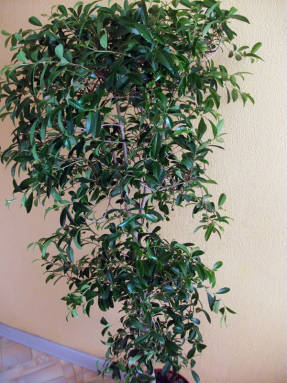
Syzygium paniculata (Syzygiumpaniculatum, Eugeniapaniculata), until recently known as Evgeniya myrtolistnaya(Eugeniamyrtifolia) - the most popular houseplant of the genus Syzygium (Syzygium) Myrtle family (Myrtaceae). Formerly syzygium paniculata and syzygium southern (Syzygium australe) described as one species - Eugenia Yuzhnaya (Eugenia australis), but now they have acquired the status of independent species.
Its natural area of distribution is in Australia, on the coast of New South Wales. In Australia it is called Purple Lilly Pilly. The species is considered endangered and is on the verge of extinction in the wild.
In nature, this is a beautiful compact tree (up to 15 m) or shrub. Small, 3-10 cm, glossy leaves, spear-shaped or elliptical, opposite, hence the generic name from the Greek syzygos - which means "paired". The variegated variety is very attractive. The leaves contain glands with essential oils. New growth is reddish, young branches are tetrahedral. With age, the bark flakes off slightly.
In spring or early summer, the tree is covered with many white flowers collected in a brush, hence the specific name - paniculate. The flowers are typical for myrtle, have 4 petals, but the main decorative effect is given by the many protruding stamens. In autumn, edible berries about 2 cm in diameter, purple or violet in color, ripen. Because of its fruits, it is also called the Purple Cherry. The fruits are collected in a bunch, like grapes. The berries are very rich in vitamin C, the people call this plant the Angina tree, chewing the berries helps with throat ailments. The fruits are crispy, sour in taste, and delicious jams are made from them.
Syzygium paniculata perfectly tolerates a haircut, in countries with a warm climate it is used to create hedges.
The plant feels confident in countries with a subtropical climate. The minimum critical temperature is -4 ...- 6 degrees. Prefers rich and moist soils, with a slightly acidic reaction. Location - in direct sun or light shade.
Maintenance and care in room conditions

In room conditions, paniculata syzygium requires the same care as common myrtle. The best place would be a glazed balcony that does not freeze in winter or a subtropical greenhouse. In the spring, the plant is covered with bunches of white flowers, and in the fall, purple berries ripen, and the harvest can be good.
Illumination. Direct sun for at least 4-5 hours a day is desirable.
Soil composition. The soil is slightly acidic, peaty with the addition of sod land and sand (3: 1: 1).
Watering regular, do not allow the substrate to dry out and moisture stagnation in the pan.
Top dressing from spring to autumn with universal fertilizers.
In winter time with a lack of light, the syzygium needs to arrange a rest period in a bright place with a temperature of + 5 + 100C and moderate, without drying, watering.
Syzygium lends itself perfectly the formation, itself grows in a compact dense bush, very decorative. Suitable for growing in bonsai style. Although its leaves are not as rich in essential oils as the closest relative of the clove tree or the common myrtle, it is very useful to keep this plant at home.

Reproduction. Syzygium is propagated by semi-lignified cuttings in greenhouses. Seeds quickly lose their germination and behave differently when sowing.
Pests. It is possible that aphids, mealybugs and scale insects are affected.
Read more about pest control measures in the article Houseplant pests and control measures.









